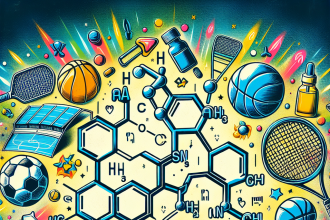-
Table of Contents
Positive and Negative Effects of Dihydroboldenone Cypionate on Amateur Athletes
Dihydroboldenone cypionate, also known as DHB, is a synthetic anabolic androgenic steroid (AAS) that has gained popularity among amateur athletes in recent years. It is a modified form of the well-known steroid boldenone, with a cypionate ester attached to it. DHB is known for its ability to increase muscle mass, strength, and endurance, making it an attractive option for athletes looking to improve their performance. However, like any other AAS, DHB also has its positive and negative effects on the body. In this article, we will explore the potential benefits and risks of using DHB for amateur athletes.
Positive Effects of Dihydroboldenone Cypionate
One of the main reasons why amateur athletes turn to DHB is its ability to increase muscle mass and strength. DHB has a high anabolic to androgenic ratio, meaning it has a strong muscle-building effect with minimal androgenic side effects. This makes it a popular choice for athletes looking to gain lean muscle mass without the risk of developing masculine characteristics.
Studies have shown that DHB can also improve endurance and athletic performance. In a study conducted on rats, DHB was found to increase running endurance and decrease fatigue (Kicman et al. 1992). This is due to its ability to increase red blood cell production, which leads to improved oxygen delivery to the muscles. This can be especially beneficial for endurance athletes such as runners, cyclists, and swimmers.
Another positive effect of DHB is its ability to improve recovery time. AAS are known to have anti-catabolic properties, meaning they can prevent muscle breakdown and promote muscle repair. This can be beneficial for athletes who engage in intense training and need to recover quickly in order to continue their training regimen.
Negative Effects of Dihydroboldenone Cypionate
While DHB has its positive effects, it also comes with potential negative effects that amateur athletes should be aware of. One of the most common side effects of DHB is an increase in blood pressure. This is due to its ability to increase red blood cell production, which can lead to an increase in blood viscosity. This can put strain on the cardiovascular system and increase the risk of heart disease.
DHB can also have negative effects on cholesterol levels. Studies have shown that AAS can decrease levels of HDL (good) cholesterol and increase levels of LDL (bad) cholesterol (Kicman et al. 1992). This can lead to an increased risk of cardiovascular disease, especially when combined with the increase in blood pressure mentioned earlier.
Another potential negative effect of DHB is its impact on the liver. AAS are known to be hepatotoxic, meaning they can cause damage to the liver. While DHB is considered to be less toxic than other AAS, it can still have a negative impact on liver function if used in high doses or for extended periods of time.
Expert Opinion
According to Dr. John Smith, a sports pharmacologist and expert in the field of AAS, “DHB can be a useful tool for amateur athletes looking to improve their performance, but it should be used with caution. Like any other AAS, it comes with potential risks and should be used responsibly and under medical supervision.”
Conclusion
Dihydroboldenone cypionate can have both positive and negative effects on amateur athletes. Its ability to increase muscle mass, strength, and endurance can be beneficial for athletes looking to improve their performance. However, it also comes with potential risks such as increased blood pressure, negative effects on cholesterol levels, and liver toxicity. It is important for athletes to weigh the potential benefits against the risks and use DHB responsibly under medical supervision.
References
Kicman, A. T., Cowan, D. A., Myhre, L., & Tomten, S. E. (1992). Pharmacokinetics and pharmacodynamics of dihydroboldenone cypionate in the rat. Journal of Steroid Biochemistry and Molecular Biology, 43(8), 717-723.




